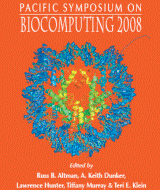Use of an Evolutionary Model to Provide Evidence for a Wide Heterogenity of Required Affinities Between Transcription Factors and Their Binding Sites in Yeast
Richard W. Lusk 1, Michael B. Eisen 2
1 Department of Molecular and Cell Biology, University of California, Berkeley
Berkeley, California 94720, USA; 2 Genomics Division, Lawrence Berkeley National Laboratory, Department of Molecular
and Cell Biology, University of California, Berkeley
Berkeley, California 94720, USA
E-mail: lusk@berkeley.edu www.berkeley.edu; mbeisen@lbl.gov www.lbl.gov
Pac Symp Biocomput. 2008;:489-500.

Abstract
The identification of transcription factor binding sites commonly relies on the interpretation of scores generated by a position weight matrix. These scores are presumed to reflect on the affinity of the transcription factor for the bound sequence. In almost all applications, a cutoff score is chosen to distinguish between functional and non-functional binding sites. This cutoff is generally based on statistical rather than biological criteria. Furthermore, given the variety of transcription factors, it is unlikely that the use of a common statistical threshold for all transcription factors is appropriate. In order to incorporate biological information into the choice of cutoff score, we developed a simple evolutionary model that assumes that transcription factor binding sites evolve to maintain an affinity greater than some factor-specific threshold. We then compared patterns of substitution in binding sites predicted by this model at different thresholds to patterns of substitution observed at sites bound in vivo by transcription factors in S. cerevisiae. Assuming that the cutoff value that gives the best fit between the observed and predicted values will optimally distinguish functional and non-functional sites, we discovered substantial heterogeneity for appropriate cutoff values among factors. While commonly used thresholds seem appropriate for many factors, some factors appear to function at cutoffs satisfied commonly in the genome. This evidence was corroborated by local patterns of rate variation for examples of stringent and lenient p-value cut- offs. Our analysis further highlights the necessity of taking a factor-specific approach to binding site identification.
[Full-Text PDF] [PSB Home Page]